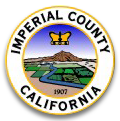
Water Quality in the Imperial Valley
Agricultural Management Practices to Improve Drainage Water Quality
Ali Montazar
Section 303(d) of the Clean Water Act requires California Regional Water Quality Control Boards (CRWQCBs) to identify surface water bodies that do not comply with the applicable water quality standards. California Regional Water Quality Control Boards are in the process of developing total maximum daily loads (TMDLs) that define how much of a “pollutant” a water body can tolerate on a daily basis. Regional Boards are also expected to establish TMDLs for the identified pollutants and set limits for these pollutants such that these water bodies attain their “beneficial” uses. The list of water bodies in this region that are considered “impaired” includes the Alamo River, New River, Imperial Valley Agricultural Drains, Salton Sea, and Coachella Valley Storm Water Channel. According to the list major “pollutants” impairing these waters are silt, pesticides, salts, nutrients (mainly phosphorus), and other pollutants. Currently the two TMDLs of concern to us are the Salton Sea Nutrient TMDL and the silt/sediments TMDLs for drains and rivers in this region. Once the TMDLS are fully approved by the appropriate state and federal authorities, growers usually have one to two years implement management practices to improve the quality of drainage water. Here is a partial list of alfalfa irrigation/fertigation management practices that may improve the quality of runoff water and achieve the objectives of the silt/sediments and nutrient (phosphorus) TMDLs. Information about additional practices can be obtained from our office (760-352-9474, kmbali@ucdavis.edu) or from the Imperial County Farm Bureau (see contact information below).
1- Irrigation water management- determining and controlling the rate, amount, and timing of irrigation water applied to minimize soil erosion, runoff, and fertilizer movement in surface runoff water.
2- Runoff reduction- reducing the amount of surface runoff, using a runoff reduction method developed by UCCE. Runoff can be reduced during irrigation events when water-run P fertilizer is applied. Runoff water can be reduced to less than 5% of applied water. Impact of reduced water application on yield is minimal when this practice is limited to one or two irrigation events out of approximately 16 irrigations per year.
3- Precision application rates/GIS utilization- within a particular field, applying precise amounts of P-fertilizer to the soil in specific parts of the fields according to the plant needs. Generally, lower rates can be applied, especially where soil/plant tests show residues are present from previous applications. GIS grids can be established in the field. Broadcast-P application rates in each grid can be based on soil and plant tests.
4- Proper fertilizer applications- selecting the proper time and method of fertilizer application (water-run P applications vs. broadcast-P applications) to reduce P losses through runoff and soil erosion.
5- Filter strip- a section of land in permanent vegetation, established down slope of agricultural operations to control erosion and slow, reduce, or eliminate pollutants from entering water ways.
For additional information contact UCCE or the Imperial County Farm Bureau at the address below. Nicole Rothfleisch (nicole@ivtmdl.com) Imperial County Farm Bureau Voluntary TMDL Compliance Program Director 1000 Broadway El Centro, CA 92243 Tel: 760-352-3831
